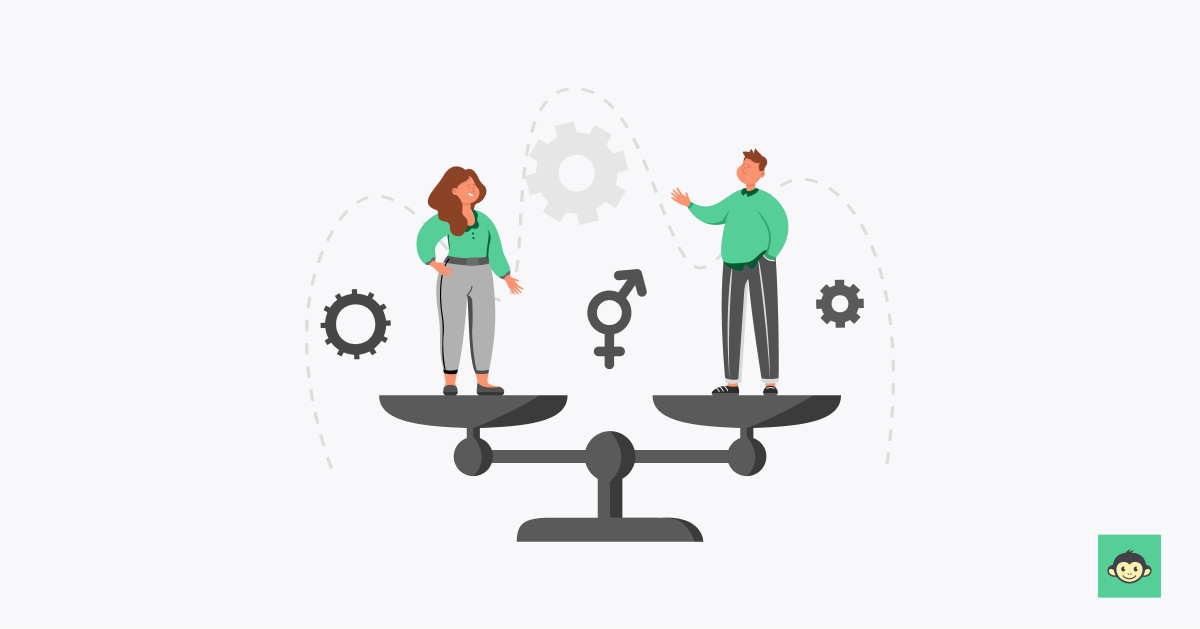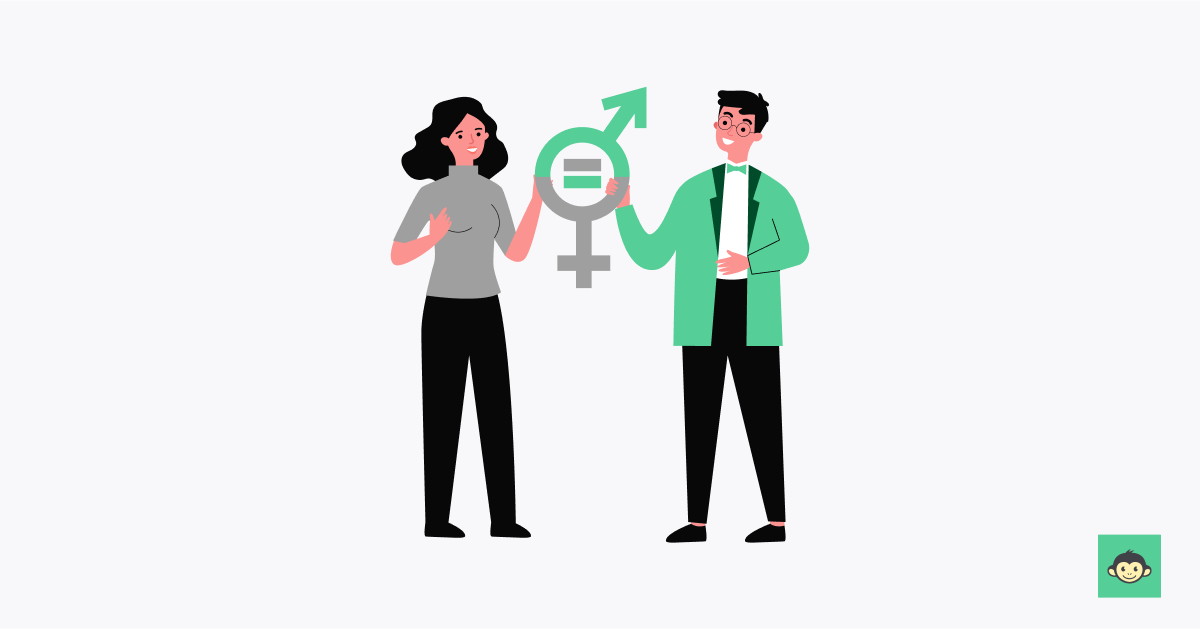How to curb women discrimination in the workplace in 2024: A complete guide

It's crucial to review and address key aspects surrounding diversity and inclusion continuously. Let's address a critical issue head-on – women experiencing gender discrimination while in the workplace.
In a world where progress is the name of the game, it's disheartening to see gender disparities persist. From unequal pay to subtle biases, the landscape needs a shake-up.
Join us as we explore the dynamics of workplace gender discrimination, unpacking keywords and insights to pave the way for change. It's not just about policies; it's about creating a workplace where every woman thrives.
Ready to dive in? Let's go!
What is gender discrimination at work?

Gender discrimination at work, often rooted in historical biases, encompasses a range of unfair practices. It's the unjust treatment of individuals based on their gender, violating principles of federal law like the Equal Pay Act and Title VII.
This discrimination extends beyond overt acts, seeping into the subtleties of daily work life, impacting women across various sectors and in other forms, too.
Picture this: unequal pay, biased performance evaluations, or even being treated differently based on personal reasons. Women face a multifaceted challenge in the workplace, where gender stereotypes and harassment based on gender or sexual nature persist. It's a complex issue that negatively affects job responsibilities and the entire work environment.
In 2024, the need for an equal opportunity and discrimination-free environment is more crucial than ever. Understanding gender discrimination is the first step towards dismantling these barriers and fostering workplaces where everyone, regardless of their gender, sexual orientation or identity, can flourish.
How is there inequality in the workplace for women?

Navigating the professional landscape, women encounter a labyrinth of inequality. Workplace gender discrimination is glaringly evident in the persistent wage gap, where female employees earn less than their male counterparts for the same job.
This wage discrimination extends its grip even into job applications, affecting the opportunities available to women right from the start.
Picture this scenario: female workers, despite equal qualifications, find themselves employed in low-wage positions, contributing to the broader issue of a low-wage workforce predominantly comprising women.
The unequal treatment experienced by women is not limited to finances; it extends to health insurance benefits, further emphasizing the need for equal treatment across the board.
Moreover, the issue of pregnancy discrimination in the workplace adds a layer of complexity. Female employees may find themselves treated differently than male employees due to personal reasons related to pregnancy, impacting their job responsibilities and creating a hostile work environment.
In this web of workplace discrimination and inequality, understanding the dynamics is essential for leaders seeking change.
By recognizing and dismantling these barriers, we pave the way for a workplace that embraces diversity and champions gender equality. Let's uncover more insights into the causes and consequences of gender discrimination to drive meaningful transformation.
What are the leading causes of gender discrimination in the workplace?

Sex discrimination in the workplace can manifest in various forms, stemming from deep-rooted biases and stereotypes. The leading causes of sex discrimination include:
Deep-rooted gender stereotypes:
Gender stereotypes play a pervasive role, influencing every facet of the workplace. From recruitment processes to the allocation of job responsibilities, women often find themselves confined to predefined roles shaped by societal expectations.
Breaking free from these stereotypes is crucial for unlocking the full potential of women in the professional sphere.
Incomplete enforcement of laws, like the Equal Pay Act:
Although federal laws apply (like Title VII) to establish equal employment opportunities, their effectiveness is sometimes compromised. Discrimination claims persist, signaling a need for state laws involve more robust enforcement mechanisms and increased awareness of sex discrimination laws among employers and employees alike.
Closing the gap between legislation and implementation of federal law is vital to fostering a truly equitable workplace.
In the context of federal laws, it's crucial to recognize the monumental impact of legislation such as the Civil Rights Act.
Enacted to combat discrimination on the basis of race, color, religion, sex, or national origin, the Civil Rights Act serves as a cornerstone for workplace equality, encompassing protections that significantly benefit women.
Understanding and upholding the principles embedded in this federal law is pivotal for organizations striving to create environments that reflect true diversity and inclusion.
By acknowledging the intersectionality within the workplace, organizations can actively work towards dismantling barriers and fostering an inclusive space where both women and individuals from diverse backgrounds thrive.
Unequal support for career advancements:
A subtle yet impactful cause of gender based discrimination lies in the unequal support male colleagues receive in their career journeys.
Whether it's mentorship opportunities, networking assistance, or simply a more conducive work environment, women often face additional hurdles on the path to professional advancement. Bridging this support gap is essential for leveling the playing field.
Subtle biases in performance evaluations:
Gender discrimination comes in many forms for today's working women. In the contemporary workplace, the experiences of those employed, like Black women and Hispanic women, for example, are focal points that demand our attention.
Labor statistics illuminate a stark reality— women from these demographics often face disparities that manifest in unequal opportunities, wage gaps, and limited upward mobility. To foster genuine workplace equality, it is paramount that organizations recognize and address these challenges systematically.
Performance evaluations, intended to be objective assessments, often harbor subtle biases that disproportionately affect women. These biases can manifest in skewed feedback, affecting promotions and opportunities for growth. Recognizing and addressing these biases in evaluation processes is key to dismantling gender-based hurdles.
Historical wage gap discrepancies:
The historical wage gap, rooted in longstanding disparities, continues to cast a shadow over the labor force.
From pay history to unequal distribution of opportunities, women face systemic challenges that perpetuate economic inequality. Eradicating these historical inequities requires a concerted effort to ensure fair and equal treatment across all aspects of the professional landscape.
Addressing these root causes demands a holistic approach from leaders. By challenging stereotypes, enforcing laws effectively, providing equal support, eliminating biases, and rectifying historical discrepancies, workplaces can evolve into environments where gender equality isn't just a goal but a lived reality.
Women discrimination in the workplace definition

Women discrimination in the workplace refers to the unjust or prejudicial treatment of women based on their gender, encompassing a range of actions that impede their professional growth and create an environment of inequality.
This form of discrimination violates principles established by federal laws like Title VII and the Equal Pay Act, affecting various aspects of a woman's career, from hiring processes to job responsibilities.
It extends beyond overt acts, permeating subtle biases, gender stereotypes, and even unequal support systems, collectively contributing to a workplace where women face barriers and challenges solely because of their gender.
The definition underscores the importance of recognizing, addressing, and actively combating the factors that perpetuate discrimination against women in professional settings.
What are 7 examples of gender bias in the workplace?

These biases, often subtle and ingrained, weave themselves into the fabric of daily operations, hindering progress and perpetuating inequalities. Let's shine a spotlight on seven glaring examples of gender bias in the workplace, dissecting the nuances that demand our attention and collective action.
- Wage disparities: Despite being in the same position with equal qualifications and the same job and responsibilities, women may receive lower compensation than their male counterparts. This wage bias contributes to the persistent gender pay gap, reflecting systemic inequalities.
- Underrepresentation in leadership roles: Gender bias often manifests in the underrepresentation of women in leadership positions. Glass ceilings and invisible barriers hinder their ascent, limiting the diversity of perspectives at the decision-making table.
- Microaggressions and stereotyping: Subtle but impactful, microaggressions and stereotyping create a hostile environment. These can range from casual remarks about personal lives, gender identity and sexual orientation to reinforcing traditional gender roles, undermining a woman's professional standing.
- Unequal access to opportunities: Women may face bias when it comes to access to career-advancing opportunities such as challenging projects, mentorship programs, or professional development. This unequal distribution of opportunities stifles their career growth.
- Maternity discrimination: Pregnancy or maternity discrimination is a prevalent form of bias, where women may face adverse treatment due to pregnancy-related matters. This employment discrimination can range from prejudiced hiring practices to reduced opportunities post-maternity leave.
- Double standards in performance evaluation: Gender bias may seep into performance evaluations, with women facing higher standards or receiving less constructive feedback compared to their male counterparts. This can directly impact promotions and career progression.
- Unconscious bias in recruitment: Unconscious bias in recruitment processes can lead to the preference of one gender over another. From skewed language in job descriptions to subjective decision-making, these biases impact who gets hired and who doesn't.
From unequal pay to double standards in evaluations, each example reinforces the urgency of creating workplaces free from gender bias.
Leaders, armed with this knowledge, have the power to foster environments where merit triumphs over gender, diversity flourishes, and everyone has an equal shot at success.
Women in the workplace statistics you should know

- CEO Representation in the S&P500: Examining the S&P500 reveals a stark gender disparity at the helm. As of February 2023, women secure merely 8.2% of CEO positions within these prominent companies, highlighting the pressing need for increased representation.
- Global Rise in Senior Management Roles: Globally, there is a positive trend in senior management roles. A study in 2021 shows the proportion of women in such positions reached an all-time high of 31%. Notably, 90% of companies worldwide now boast the presence of at least one woman in a senior management role, showcasing a shift towards more inclusive leadership.
- Managerial Presence in Corporate America: According to the 2021 Women in the Workplace report by LeanIn.Org and McKinsey, women account for 41% of all manager-level positions in corporate America. While this signals progress, challenges persist on the path to achieving gender equality in managerial roles.
- Earnings Disparities Persist: The gender pay gap persists as of 2021, with the median weekly earnings of full-time working women amounting to 83.1% of their male counterparts. This statistic accentuates the ongoing struggle for pay equity, necessitating a reevaluation of workplace structures and compensation practices.
- Unwanted sexual advances: In an ABC News/Washington Post survey conducted, 54% of women said they have received unwanted sexual advances from a man that they felt were inappropriate whether or not those advances were work-related; 30% said this had happened to them at work.
Leadership diversity is on the rise, albeit a slow process, evidently. These compelling statistics illuminate both progress and persistent challenges for women in the workplace. Understanding these figures is paramount for crafting strategies that foster gender equity, representation, and fair compensation.
How to deal with workplace gender discrimination at the workplace as a leader?

Addressing workplace gender discrimination as a leader requires a proactive and committed approach. Here are steps you can take to deal with gender discrimination effectively:
- Promote equal opportunities: Actively champion policies and practices that ensure fair employment and equal opportunities for all. Encourage diverse hiring, fair promotions, fair employment, and inclusive professional development to mitigate gender-based disparities.
- Implement transparent pay structures: Foster transparency in pay structures to eliminate gender-based wage gaps. Regularly review compensation, ensure fairness, and address any discrepancies promptly, reinforcing your commitment to pay equity.
- Cultivate a diverse leadership team: Strove for diversity in leadership. Recognize the importance of varied perspectives by actively promoting and supporting the career growth of women within your organization. This commitment not only combats discrimination but enriches decision-making processes.
- Establish clear anti-discrimination policies: Develop and communicate robust anti-discrimination policies explicitly addressing gender bias. Ensure that every member of the organization understands the consequences of discriminatory behavior and feels confident using legal action to report gender discrimination.
- Encourage open communication: Create a culture that encourages open communication. Actively seek feedback from women in your organization about their experiences, concerns, and suggestions for improvement. Anonymous surveys and regular check-ins can provide valuable insights.
- Offer diversity, equity, and inclusion (DEI) training: Implement mandatory DEI training programs for all employees. These sessions can raise awareness about unconscious biases, promote empathy, and equip your team with the tools to actively combat discrimination.
- Establish mentorship and sponsorship programs: Foster mentorship and sponsorship programs specifically designed to support the career development of women. Pairing aspiring female leaders with experienced mentors can provide guidance and open doors to new opportunities.
- Lead by example: Demonstrate your commitment to equality through your actions. Showcase inclusive behaviors, actively listen to diverse perspectives, and hold yourself accountable for fostering a workplace free from discrimination.
- Address microaggressions swiftly: Microaggressions can perpetuate discrimination. Train your team to recognize and address these subtle biases promptly. Create a culture where microaggressions are not tolerated, fostering a more respectful work environment.
- Regularly evaluate and adjust policies: Periodically review your organization's policies and practices. Stay informed about evolving best practices in diversity and inclusion, and be willing to adapt your approach to ensure ongoing progress.
By adopting these proactive measures, you, as a leader, can contribute significantly to mitigating and eventually eradicating discrimination against women in the workplace.
Remember, the journey towards equality is ongoing, and your commitment plays a pivotal role in shaping a workplace that celebrates diversity and inclusion.
How can DEI surveys enable you to listen to the anonymous feedback on women discrimination?

When building equitable workplaces, understanding and addressing women discrimination is an imperative task for leaders. Diversity, Equity, and Inclusion (DEI) surveys are a powerful tool in this journey.
These surveys act as a barometer for many women's experiences within an organization and provide a confidential space for candid feedback, enabling leaders to identify, address, and eradicate discrimination effectively.
Let's delve into how DEI surveys serve as a catalyst for change.
- Anonymous platform for honest expression: DEI surveys provide a confidential space where employees can share their experiences without fear of repercussions. This anonymity encourages candid feedback, allowing many women to express concerns about discrimination openly.
- Targeted questions on gender equality: Inclusion of specific questions related to gender equality and discrimination in DEI surveys ensures a focused exploration of women's experiences. This targeted approach helps in gathering relevant data to identify patterns and areas of concern.
- Quantifiable data for informed decision-making: DEI surveys generate quantifiable data, offering leaders a clear understanding of the prevalence and impact of discrimination. By analyzing this data, organizations can identify trends, assess the severity of issues, and prioritize interventions effectively.
- Benchmarking against industry standards: DEI surveys often include industry benchmarks, enabling organizations to compare their results against broader standards. This external perspective helps in assessing whether the reported discrimination is an industry-wide challenge or specific to the organization.
- Inclusion of intersectionality questions: Intersectionality questions in DEI surveys consider the interconnected nature of discrimination. By understanding the unique challenges faced by women of different backgrounds, organizations can tailor solutions that address the diverse experiences within the workforce.
- Real-time pulse on organizational climate: Conducting DEI surveys regularly provides a real-time pulse on the organizational climate. This continuous feedback loop allows leaders to track progress, identify emerging issues, and respond promptly to evolving dynamics related to women's discrimination.
- Customizable for targeted insights: DEI surveys can be customized to gather insights on specific aspects of women's discrimination. Whether it's biased hiring practices, unequal promotion opportunities, or microaggressions, tailored questions elicit detailed feedback for targeted problem-solving.
- Actionable recommendations from employees: DEI surveys often include open-ended questions, allowing employees to propose actionable recommendations for improvement. Leveraging these suggestions empowers organizations to co-create solutions with their workforce, fostering a collaborative approach to combating discrimination.
- Engagement and trust building: The mere act of conducting DEI surveys demonstrates an organization's commitment to listening and addressing concerns. This engagement builds trust among employees, encouraging a culture of openness and reinforcing the belief that their feedback matters.
- Data-driven DEI strategies: Armed with insights from DEI surveys, leaders can formulate data-driven strategies. These strategies, backed by the experiences and perceptions of employees, become more effective in dismantling discriminatory practices and promoting a truly inclusive workplace.
The journey towards workplace equality is ongoing, and with DEI surveys as a guiding compass, leaders can pave the way for a culture that values every voice, dismantles biases, and fosters an environment where every woman can thrive.
How can proper DEI awareness solve gender inequality in the workplace?

Addressing gender inequality requires a multifaceted approach, and proper Diversity, Equity, and Inclusion (DEI) awareness plays a pivotal role.
Cultivating inclusive leadership:
Proper DEI awareness fosters inclusive leadership by emphasizing the importance of recognizing and valuing diverse perspectives. Leaders, equipped with this awareness, can champion gender equality initiatives, creating environments where women feel valued and included.
Unveiling unconscious biases:
DEI awareness training unveils unconscious biases that may perpetuate gender inequality. By acknowledging and addressing these biases, organizations can dismantle ingrained stereotypes and foster a more equitable and unbiased workplace.
Enhancing recruitment practices:
Heightened DEI awareness prompts organizations to reevaluate and adjust their recruitment practices. By actively seeking diverse talent pools and implementing unbiased hiring processes, organizations can mitigate gender-based disparities from the outset.
Implementing fair compensation practices:
DEI awareness brings attention to the gender pay gap. Organizations, with heightened awareness of this issue, can implement fair compensation practices, ensuring that women receive equitable pay for comparable roles, thus narrowing the wage disparity.
Creating supportive work cultures:
A focus on DEI awareness contributes to the creation of supportive work cultures. By promoting inclusivity and understanding, organizations can cultivate environments where women feel empowered to voice concerns, share experiences, and actively participate in decision-making processes.
Providing equal opportunities for growth:
DEI awareness emphasizes the importance of providing equal opportunities for professional growth. Organizations, guided by this awareness, can implement mentorship programs, leadership development initiatives, and fair promotion practices, ensuring women have pathways to advance in their careers.
Mitigating workplace harassment:
DEI awareness underscores the importance of a zero-tolerance policy for workplace and sexual harassment everywhere. Organizations with keen awareness of gender based harassment-related issues can implement robust anti-harassment measures, fostering a safe and respectful environment for all employees.
Encouraging open communication:
DEI awareness encourages open communication about gender-related challenges. By fostering a culture where employees feel comfortable discussing these issues, organizations can address concerns promptly, creating an environment that actively works towards gender equality.
Leveraging employee resource groups (ERGs):
DEI awareness encourages the formation and support of Employee Resource Groups (ERGs) focused on gender equality. These groups provide platforms for shared experiences, networking, and collaborative initiatives, amplifying the impact of DEI efforts within the organization.
Aligning policies with inclusivity goals:
Organizations with DEI awareness align their policies with inclusivity goals. This includes parental leave policies, flexible work arrangements, and other initiatives that support the unique needs of women in the workplace, contributing to a more balanced and inclusive work environment.
As organizations strive for gender equality, integrating DEI awareness into every facet of the workplace emerges as a transformative strategy.
Conclusion
In our exploration of curbing discrimination in the workplace, it's clear that fostering a culture of inclusivity and equity is not just a responsibility but a necessity for progressive organizations.
By embracing diversity, addressing biases, and championing gender equality, we pave the way for workplaces where every individual, regardless of gender, can flourish. Ready to take your organization's culture to the next level?
Explore the transformative solutions Culture Monkey offers and improve your human resources game. Visit CultureMonkey.com now and empower your workplace with tools that drive diversity, equity, and inclusion. Let's make every workplace a space where every voice is heard and respected.



